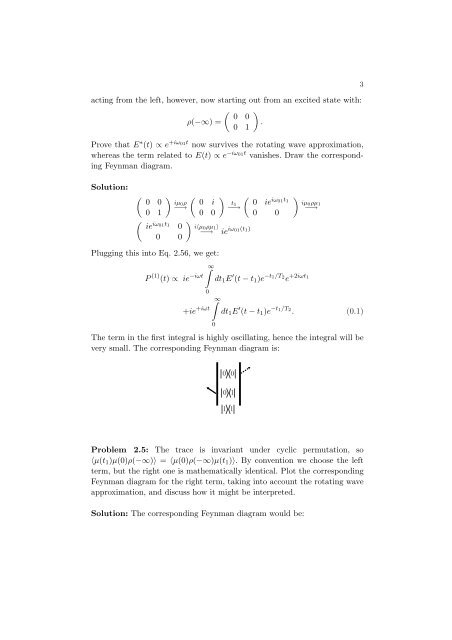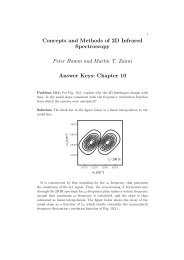Peter Hamm and Martin T. Zanni - 2D IR spectroscopy
Peter Hamm and Martin T. Zanni - 2D IR spectroscopy
Peter Hamm and Martin T. Zanni - 2D IR spectroscopy
You also want an ePaper? Increase the reach of your titles
YUMPU automatically turns print PDFs into web optimized ePapers that Google loves.
acting from the left, however, now starting out from an excited state with:<br />
ρ(−∞) =<br />
� 0 0<br />
0 1<br />
Prove that E ∗ (t) ∝ e +iω01t now survives the rotating wave approximation,<br />
whereas the term related to E(t) ∝ e −iω01t vanishes. Draw the corresponding<br />
Feynman diagram.<br />
Solution:<br />
�<br />
0 0<br />
0 1<br />
�<br />
iω01t1 ie 0<br />
0 0<br />
� �<br />
iµ0ρ 0 i<br />
−→<br />
0 0<br />
� i〈µ0ρµ1〉<br />
−→ ie iω01(t1)<br />
�<br />
.<br />
� �<br />
iω01t1<br />
t1 0 ie<br />
−→<br />
0 0<br />
� iµ0ρµ1<br />
−→<br />
Plugging this into Eq. 2.56, we get:<br />
P (1) (t) ∝ ie −iωt<br />
�∞<br />
dt1E ′ (t − t1)e −t1/T2 +2iωt1 e<br />
0<br />
+ie +iωt<br />
�<br />
0<br />
∞<br />
dt1E ′ (t − t1)e −t1/T2 . (0.1)<br />
The term in the first integral is highly oscillating, hence the integral will be<br />
very small. The corresponding Feynman diagram is:<br />
0<br />
0<br />
1<br />
Problem 2.5: The trace is invariant under cyclic permutation, so<br />
〈µ(t1)µ(0)ρ(−∞)〉 = 〈µ(0)ρ(−∞)µ(t1)〉. By convention we choose the left<br />
term, but the right one is mathematically identical. Plot the corresponding<br />
Feynman diagram for the right term, taking into account the rotating wave<br />
approximation, <strong>and</strong> discuss how it might be interpreted.<br />
Solution: The corresponding Feynman diagram would be:<br />
0<br />
1<br />
1<br />
3



